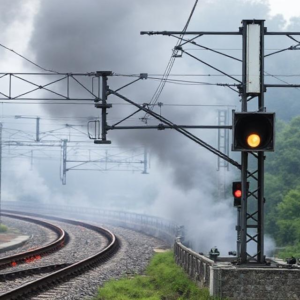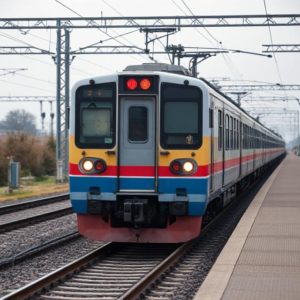Railway data communication systems are the technologies that allow different parts of the railway network (like trains, stations, control centers, and maintenance teams) to exchange information. These systems are crucial for the smooth operation of trains, ensuring safety, efficiency, and coordination. Let’s break it down in an easy way!
1. What is Railway Data Communication?
Railway data communication refers to the exchange of information between various devices and systems used in railway operations. This information can be about train movements, station operations, safety alerts, or maintenance data. The goal is to ensure everything runs smoothly, from train schedules to track conditions.
2. Why is Railway Data Communication Important?
- Safety: It helps keep track of train locations, ensuring trains don’t collide or run off schedule.
- Efficiency: It helps control the movement of trains and manage traffic on the tracks, making sure trains run on time and without delays.
- Coordination: It allows different parts of the railway (stations, trains, and control centers) to communicate and stay in sync with each other.

3. Types of Railway Data Communication Systems:
a. Train-to-Ground Communication (Trackside Communication):
- How it Works: This system allows trains to communicate with control centers and stations while traveling on the tracks. It uses wireless signals, such as radio frequencies, to send and receive data.
- Why it’s Important: It ensures that the train can send important data (like its position or speed) to control centers, which helps manage train traffic and prevent accidents.
- Example: If a train is approaching a busy station, it sends data about its speed and location to the control center, which can then manage other trains nearby.
b. Onboard Communication Systems:
- How it Works: Onboard systems enable communication between the train crew (like the driver and conductor) and control centers. They use technologies like satellite or radio communication to send real-time updates about the train’s status.
- Why it’s Important: It allows the train crew to receive updates about track conditions, signals, and any potential problems ahead (such as construction or weather issues).
- Example: If there’s a signal change ahead or a speed limit modification due to track work, the train driver will receive this information immediately through the onboard system.
c. Control Center Communication (Centralized Traffic Control):
- How it Works: The control center is the heart of the railway communication system. It receives data from trains and stations, tracks train movements, and manages the overall flow of the railway network.
- Why it’s Important: This system ensures that train movements are coordinated across different areas, preventing accidents and delays by managing schedules and track usage.
- Example: If a train is delayed, the control center can adjust the schedules of other trains to prevent a backlog and ensure smooth operations.
d. Trackside Equipment Communication:
- How it Works: Trackside equipment, like sensors or signals, sends information to control centers and trains. These systems help monitor track conditions (like temperature, wear, or obstructions) and send real-time data.
- Why it’s Important: It helps detect potential problems with the tracks and provides early warnings to prevent accidents or delays.
- Example: If a track sensor detects a fault or obstruction on the tracks, it will notify the control center, which can then take action to prevent the train from passing over that section.
e. Passenger Information Systems:
- How it Works: These systems use data communication to provide passengers with real-time information about their train’s status, including delays, arrival times, and station announcements.
- Why it’s Important: It ensures passengers stay informed about their journey, reducing confusion and making the travel experience more comfortable.
- Example: Passengers can see live updates about their train’s delay on digital boards or receive announcements about the next stop.
f. Wireless Communication Systems (Wi-Fi & 4G/5G):
- How it Works: Some trains offer Wi-Fi or use mobile networks (like 4G/5G) to communicate with stations or even allow passengers to stay connected during their journey.
- Why it’s Important: For passengers, it allows internet access, but it’s also important for sending and receiving important operational data like train location or condition updates.
- Example: Passengers can use Wi-Fi to browse the internet, and train operators can use the same system to send data to the control center.
g. Data Networks and Protocols:
- How it Works: To manage and organize all the data being exchanged, railway networks use data protocols and networks that ensure information is sent securely and correctly between different systems. These include technologies like Ethernet, TCP/IP, and other specialized railway communication protocols.
- Why it’s Important: Data protocols ensure that messages (like train positions, signals, or schedules) are transmitted in a format that can be understood and acted upon by the receiving system.
- Example: If a train sends its location data to the control center, the protocol makes sure that data is formatted in a way that the control center can understand and use to track the train.
h. Satellite Communication Systems (GPS):
- How it Works: GPS (Global Positioning System) is used by trains to determine their exact location on the track. This data is sent to control centers, allowing them to track the movement of trains in real time.
- Why it’s Important: GPS ensures that trains are monitored continuously, preventing them from getting off track and improving safety and scheduling.
- Example: The train can send its GPS coordinates to the control center, allowing operators to monitor its location and schedule updates in real time.
4. How These Systems Work Together:
All the different communication systems work together to ensure that train operations are safe and efficient. Here’s how they interact:
- Control Centers receive data from the trains and trackside sensors, monitor the status of the rail network, and adjust train schedules accordingly.
- Trains use communication systems like Wi-Fi, GPS, and radio to send their location, speed, and condition to the control center, which helps keep everything running smoothly.
- Trackside equipment communicates data about track conditions and signals to ensure safety.
- Passenger Information Systems share data about train arrival times, delays, and stops, helping passengers plan their journey.
5. Advantages of Railway Data Communication Systems:
- Improved Safety: Data communication ensures that the control center can monitor trains and signals in real-time, preventing accidents.
- Efficiency: Trains can be better coordinated, reducing delays and managing traffic effectively on busy rail networks.
- Real-time Updates: Passengers receive up-to-date information about delays, train arrivals, and schedules, improving their travel experience.
- Better Maintenance: Data from sensors and onboard systems helps detect faults or wear before they cause major issues, leading to better maintenance and fewer disruptions.
6. Challenges of Railway Data Communication:
- Cost: Implementing and maintaining these systems can be expensive for railway operators.
- Data Security: Since these systems handle a lot of sensitive data (e.g., passenger information, train locations), ensuring data security is crucial to prevent hacking or data breaches.
- Connectivity Issues: In remote areas or during extreme weather conditions, data communication systems may experience disruptions, making it harder to track trains or relay important information.
7. In Summary:
Railway data communication systems are the backbone of modern train operations. They allow trains, stations, control centers, and passengers to communicate important information in real-time. These systems ensure the safe, efficient, and smooth operation of the railway network by enabling data exchange about train locations, schedules, safety, and maintenance. From preventing accidents to keeping passengers informed, these communication systems are key to making rail travel safer and more comfortable.
Keywords: Railway data communication system, Railway











